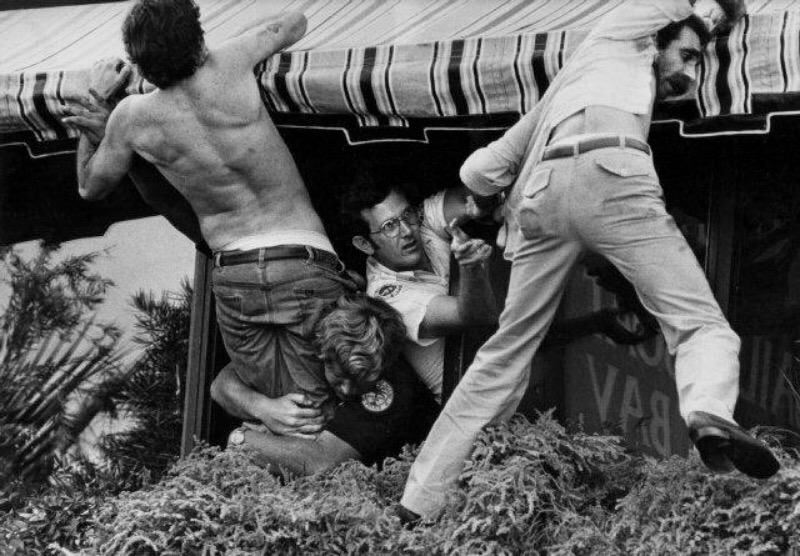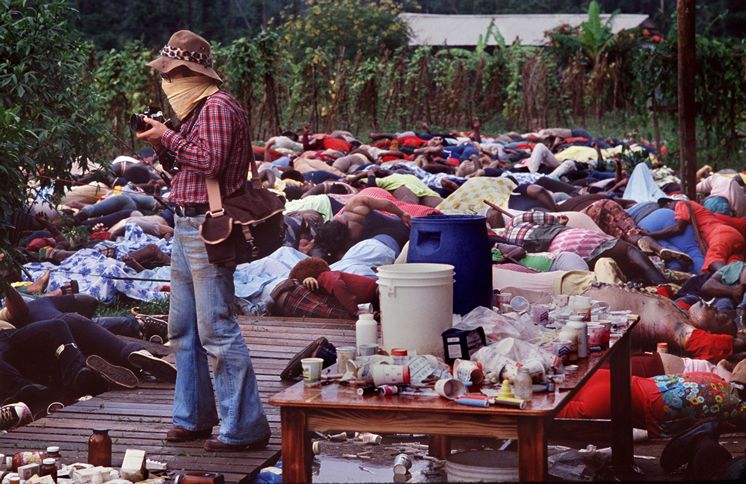
HistoryMiami exhibit revisits major events through the lens of renowned photojournalist Tim Chapman

Above: Men who were allegedly selling crack cocaine in the Mutiny Hotel in Coconut Grove attempt to flee during the Cocaine Cowboys era. Photo by Tim Chapman/Courtesy HistoryMiami, Tim Chapman Collection.
Note: One of the images below may be too graphic for some readers.
Michele Reese is the public relations and marketing manager for HistoryMiami Museum, a winner of the Knight Arts Challenge.
Sifting through images in Tim Chapman’s collection is one of the greatest history lessons I have ever had. If a notable event happened in Miami, South Florida or beyond over the last four decades, you can bet he was there, capturing it with his camera as a photojournalist with the Miami Herald. He loved news and it showed. When he retired four years ago, he gifted his collection to the HistoryMiami Museum. His storied career covered everything from riots and waves of refugees to hurricanes and mass suicides.
But starting this month, you won’t have to go through his collection of 750,000 images to get an idea of what he captured over his time as a photojournalist. You can get a curated glimpse at his collection when “Newsman: The Photojournalism of Tim Chapman” opens at the HistoryMiami Museum on Friday, April 15. The exhibit will feature everything from the devastation of Hurricane Andrew to the chaos of the “Cocaine Cowboys” era to the waves of refugees leaving Cuba during the Mariel Boatlift.

A war orphan at the Santa Tecla refugee camp during the long civil war in El Salvador. Photo by Tim Chapman/Courtesy HistoryMiami, Tim Chapman Collection.
Perhaps the most moving images that caught my eye are the ones taken in 1978 after the mass suicide and murders at Jonestown in Guyana. Chapman was one of only four photojournalists to walk through and cover the horrific scene, which would have seemed unimaginable if there weren’t photographs taken to prove it really happened. Another photograph that tugs at my heart strings is of a little girl, who can’t be more than 5 in the image; she is dirty and appears scared, while standing in war-torn El Salvador.
Sometimes these photographs are tough to look at, but they make you think.
Chapman had a front row seat to history. As his friend and former colleague Carl Hiaasen once wrote in the Miami Herald, “You did not send Chapman to take pictures at Art Basel… You sent him to fires and wars and plane crashes and mass suicides in Guyana…. And those of us who got to ride with him in those kick-ass days cherish every harrowing memory.”
We will get to hear some of those memories at a special opening night conversation with Chapman and Hiaasen on April 15 at HistoryMiami Museum. The event is open to the public. Tickets are $10 for HistoryMiami members and $20 for nonmembers. The exhibit will be on display through Aug. 14.
The exhibition is part of the HistoryMiami Center for Photography, which is made possible by a Knight Arts Challenge grant. For more information, visit historymiami.org/photography.
Email Michele Reese at [email protected]. Follow her on Twitter @mreese_mia.
The Knight Arts Challenge is open for applications in Akron, Ohio, Detroit, Miami and St. Paul, Minn., through May 2. Apply at knightarts.org.

Jonestown Massacre in the jungles of Guyana, November 1978. Jim Jones is at lower right on his back, in the red shirt. The photographer pictured was from the San Francisco Examiner. Photo by Tim Chapman/Courtesy HistoryMiami, Tim Chapman Collection.
Recent Content
-
Artsarticle ·
-
Artsarticle ·
-
Artsarticle ·

